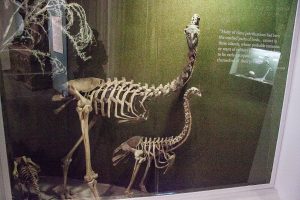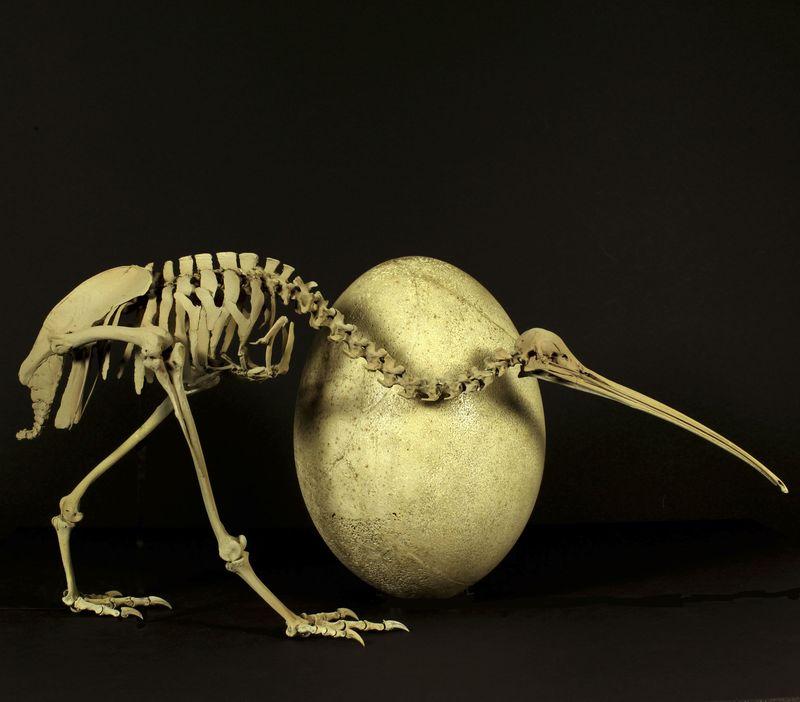Visit any major museum in Aotearoa New Zealand and you will see a giant moa skeleton on display. The first thing you notice, apart from its enormous size, is the complete lack of wing bones. The answer to how the tūpuna of moa arrived on our shores and subsequently lost their wings has been one of New Zealand’s greatest evolutionary mysteries.

Moa, and our other national bird, the kiwi, are members of an ancient super group of birds called palaeognaths (derived from the Greek for ‘old jaws’, referring to the primitive-looking roof of their mouth), very different to their evolutionary rivals, the neognaths (new jaw) that include all other birds alive today.
The moa and kiwi, along with the ostrich from Africa, rhea from South America, emu and cassowary from Australia and New Guinea, and the extinct Madagascan elephant bird (which inspired the legend of the roc in Sinbad) are members of an exclusive posse within palaeognaths, called the ratites.
Ratites share some key features. They are large (yes, even kiwi are large), flightless, and lack a keel on the breast bone for supporting flight muscles. Next time you carve your Sunday roast chicken, check out the large keel that supports the breast meat. If you don’t fly, over eons of evolution the keel is eventually lost. While the majority of ratites still have remnant wings, moa have lost all trace of them.
There’s one other player in the mix here. The South American tinamou – small, chicken sized birds that can fly. Tinamou are palaeongaths and were traditionally thought of as close cousins of ratites, but more on that later.
Like many kiwis my age I grew up thinking ratites were the poster children for Gondwanan vicariance – those animals whose ancestors were passively transported around the Southern Hemisphere as the supercontinent Gondwana broke up. Under this theory kiwi and moa were each other’s closest relatives and became isolated in Aotearoa as it started to split from eastern Gondwana around 80 million years ago.
It wasn’t until I was at university taking George Gibbs’ fantastic ‘New Zealand flora and fauna’ paper that I realised this theory had some serious holes. A decade earlier a seminal ancient DNA study had shown that kiwi and moa were not each other’s closest cousins – rather kiwi were most closely related to the emu and cassowary, and moa were their own unique lineage within ratites.

As more ancient DNA and morphological (i.e. shape of bones) data came in for moa, our understanding of how ratites evolved became more convoluted, clouded by prior assumptions about the break-up of Gondwana causing the diversification of ratites, and the flying tinamous being their close cousins. Theories abounded, were debated and then discarded as quickly as Australia does with prime ministers.
The revelation came when scientists threw out their long held assumptions (though some are still clinging to them) and conducted new and improved analyses. Suddenly, the genetic and morphological data strongly suggested tinamous were the closest relatives of moa, blowing the ratite posse apart. Further work showed the extinct Madagascan elephant bird was in fact the closest cousin of kiwi, allowing us to claim it back from the Australians when they nicked it back in the early 1990s to add to their collection of New Zealand icons.
The implications were game changing. Rather than ratites having a single origin with one loss of flight, and being passively transported across the Southern Hemisphere when Gondwana broke up, their tūpuna could fly and subsequently lost flight independently in the lineages that led to ostrich, rhea, moa, elephant bird, kiwi and emu/cassowary. Hello poster children for dispersal.

It just so happens that scientists have discovered fossils of this flying ancestor, called Lithornis. This mother of ratites had a widespread distribution prior to the extinction of the dinosaurs 65 million years ago. With the demise of these terrible lizards, job vacancies opened up in the ecosystem for large, ground-dwelling giants. Independently, on the different Gondwanan continental fragments, Lithornis filled this vacancy and lost flight. Convergent evolution, (think of the similar body plans of sharks, dolphins and extinct ichthyosaurs), resulted in the ‘ratites’ all looking superficially similar. If you are a large, ground dwelling bird, there are only so many ways you can look, given functional constraints. It’s partly this convergence in the shape of ‘ratite’ bones that was muddying the waters in tracing the whakapapa of these magnificent birds.
The ancestors of moa diverged from those of the South American tinamou around 58 million years ago, having flown to Aotearoa. By 16-19 million years ago, at the Miocene Wonderland of St Bathans, moa were already large and presumably flightless (and maybe even wingless…). In contrast, the ancestors of the kiwi didn’t split from those of the elephant bird until around 50 million years ago, and were potentially still flying around Wonderland tens of millions of years later. The vacancy for a large, ground-dwelling bird had already been filled by moa, so kiwi stayed relatively small so to speak (a similar pattern occurred with tinamous compared to rhea), and became nocturnal – traits that no doubt helped the kiwi avoid extinction when Polynesians, and later Europeans, arrived in New Zealand.
This all leads to one big evolutionary mystery. How did these flying ancestors lose flight? We probably know why they lost flight. Flying is energetically expensive. If you don’t have to fly, why bother. In New Zealand, the absence of mammalian predators is certainly a good reason. But we don’t know the how.
The recent publication of the partial moa genome, one of the holy grails of ancient DNA and a game changer, only added to the mystery. All the genes coding for wing development and flight were entirely functional. Put those genes in another bird, and it would still develop a perfectly functional pair of wings. We are not dealing with a simple case of gene loss or loss of function in the same suite of genes (i.e. convergent evolution). So what gives?
New international research, with the full support of Ngāi Tahu and Te Āti Awa, involving fellow kiwi’s Paul Gardner and Nicole Wheeler, and the late Alan Baker, may just have the answer.
By comparing the genomes of most ‘ratites’, including moa, and the tinamou, the culprit is mutations in the same suite of non-coding regulatory elements in the genomes. These are genetic regions that do not code for proteins, instead controlling their levels of production. Not only that, these regulatory elements are closely associated with the developmental pathways that allow flight, like wing development.
Think of it this way. Genes are the blue prints for building planes in a robotics factory. Regulatory elements are the computer code that controls the robots and tells them what to do. If the code functions as it should, aerodynamic planes capable of flight will be produced. But if that code is corrupted or a mistake (i.e. a mutation) is introduced, flightless planes will be built. In multiple independently owned and operated factories, mistakes start occurring in the same bits of code, and pretty soon, all planes are flightless. In the case of moa, the mistake-ridden code stopped producing wings altogether.

Sackton and colleagues have gone a long way to answering how these poster birds for evolution became flightless, and why the moa lost its wings. More ‘ratite’ genomes, especially additional moa and the extinct Madagascan elephant bird (one day…fingers crossed) would go a long way to finally resolving this debate.
In a blow to the de-extinction hopes of Trevor Mallard, having the genome of a moa doesn’t mean you can successfully bring it back from the dead, even if you are the Night King – there’s a whole world of regulation that needs to be recreated as well. No wonder the Army of the Dead can’t walk properly. Bringing back the moa, that’s a tough call.
I’m standing in front of the giant moa skeleton that’s looking down at us in Canterbury Museum with my five year old. He’s fascinated by the skeleton of one of our avian icons and excitedly proclaims it has no wings. I recount this stunning tale to my budding palaeontologist, and wonder what new secrets, hidden in the mists of time, I’ll be able to tell him next time we’re in front of this majestic bird.


Brilliant article Nic, thank you!
Hi Nic,
Is ” non-coding regulatory elements” how we’re referring to hox genes these days? Or are the changes a bit further along the developemental pathway? Lots of examples of hox gene mutations leading to pretty big morphological changes on the basis of very little genetic change. It’s obviously a bit unhelpful to refer to a gene coding “for” a trait that forms as part of an interlinked sequence, and only once in the animal’s entire life, but the terminology seems to be entrenched!